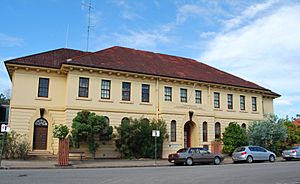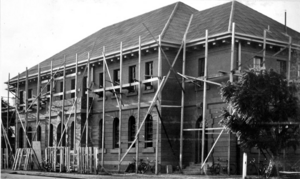Maryborough Government Offices Building facts for kids
Quick facts for kids Maryborough Government Offices Building |
|
|---|---|

Maryborough Government Offices Building, 2008
|
|
| Location | 123 Wharf Street, Maryborough, Fraser Coast Region, Queensland, Australia |
| Design period | 1919 - 1930s (interwar period) |
| Built | 1940 - 1940 |
| Architect | Gilbert Robert Beveridge, Raymond Clare Nowland |
| Architectural style(s) | Georgian |
| Official name: Maryborough Government Office Building, State Government Insurance Offices, State Government Offices | |
| Type | state heritage (built) |
| Designated | 21 October 1992 |
| Reference no. | 600713 |
| Significant period | 1930s-1940s (fabric) |
| Significant components | strong room |
| Builders | Relief work |
| Lua error in Module:Location_map at line 420: attempt to index field 'wikibase' (a nil value). | |
The Maryborough Government Offices Building is a special old office building in Maryborough, Australia. It's listed on the Queensland Heritage Register because it's an important part of history. This building was designed by architects Gilbert Robert Beveridge and Raymond Clare Nowland. It was built in 1940, during a time when the government created jobs to help people.
After some big repair work, the building was reopened in 2018. It was then renamed the Moira Hansen Maryborough Government Offices.
Contents
Building History
The Maryborough State Government Offices were planned in 1939. Architects from the Public Works Department designed them. The goal was to add more office space for the government. Before this, government offices were mostly on the ground floor of the nearby Maryborough Court House.
The building was constructed in 1940. It was built on the land next to the Maryborough Courthouse. This new building replaced a garden that used to be between the Court House and Wharf Street.
Maryborough's Early Days
The Maryborough State Government building is in an important area. This area has many large public and business buildings from the 1800s and early 1900s. These buildings are all around Wharf Street. This part of Maryborough grew because of the wharves (docks) that were built there in 1852.
Maryborough first started as a small town on the north side of the Mary River. Wharves were set up around 1847-1848 to help transport wool. But by 1852, the town moved a bit further north. This new spot was better for ships to get to. Maryborough grew quickly. By 1861, it became an official town.
Why a New Government Building?
In the late 1860s, Maryborough became very busy. This was because of the gold rushes nearby in Gympie. The first court hearings were held in local hotels. Later, a permanent courthouse and lockup were designed around 1856. These first brick buildings were finished in the early 1860s. They were on the site where the City Hall is today.
Soon, plans were made for a new, bigger courthouse. FDG Stanley, the main architect for Queensland at the time, designed it. He wanted the government offices on the ground floor. This would make them easy to reach from the street. The courtrooms would be on the upper floor, away from noise. The new Maryborough Courthouse was finished in 1877.
The courthouse was a big, two-story building. It had offices for different government groups on the ground floor. But over time, more space was needed. So, the government decided to build a new Government Offices Building. This was also part of a plan to create jobs during the Great Depression in the 1930s.
Architects GR Beveridge and RC Nowland from the Department of Public Works worked on the plans. The new building meant the courthouse gardens had to be removed. But in return, the courthouse itself was updated inside.
Today, the Maryborough Government Offices Building still houses different Queensland Government departments. It still looks much like it did when it was first built.
Building Design
The Maryborough Government Office Building is a large brick building. It is located on the corner of Wharf and Richmond Streets, right next to the Court House. It was designed to look good with the Court House.
Outside the Building
The building has a rectangular shape. Its roof is made of a special material that looks like terracotta tiles. The roof hangs over the edges, supported by decorative blocks called corbels. These add a nice line around the top of the building.
The front of the building, facing Wharf Street, is symmetrical. It has a central part and two sections on the sides. The ground floor looks like it's made of stone blocks. It has many round-arched windows. In the middle of the ground floor is a small entrance area. This entrance has a round arch with special stone-like decorations around it. Above the main door, you can see the words "Maryborough Government Office Building" carved into a stone block. The upper floor has rectangular windows with six glass panels.
The side sections of the building are set back a bit from the front. They mainly contain the stairs inside. Each side section also has a central arched doorway facing the street.
Inside the Building
The inside of the building has two levels. Many of the original features and wooden details are still there. When you enter the ground floor, you walk into a large reception area. This area has a decorative floor made of terrazzo (a mix of chips and cement). There's also a big wooden counter. From here, you can see the main office space, which is open. The main office area has decorative plaster ceilings with a grid pattern.
In one corner of the ground floor is a records room and a strong room. These were part of the original design. The strong room still has its heavy iron door. Both rooms are now used for storage. In another corner, there's a private office. This was originally the manager's office. It has original wooden floors and wood-paneled walls.
From the main office area, two hallways lead to the staircases in the side sections. The staircases are still in good condition. They have terrazzo steps and decorative cast-iron railings. The railings have a modern design with three upright bars, one of which is twisted. The handrails and posts are made of wood. These stair landings also have original wooden boards with glass panes that used to list office directories.
The upper floor has many offices. They are on both sides of a narrow hallway that runs through the middle of the building. This floor has high-quality wooden doors and other wooden features. The ceilings also have a grid pattern. Toilets are located at both ends of the upper floor.
Behind the building, there's a walkway that connects it to the courthouse. This walkway has a recently added mosaic mural on the ground. It celebrates 100 years since Australia became a federation.
Why This Building is Important
The Maryborough Government Offices Building was added to the Queensland Heritage Register in 1992. This means it's considered very important for several reasons:
- It shows Queensland's history: Built in 1940, it shows how Maryborough continued to be an important center for government work. It also shows how the government created jobs during the Great Depression.
- It's a great example of its style: The building is a good example of the "Inter-War Georgian Revival" style. This was a popular style for public buildings designed by Queensland's government architects before World War II. Its original inside features, like the strong room and offices, also show how government administration worked back then.
- It's beautiful and fits in well: The building is an important part of the Wharf Street area. This area has many old, grand buildings that look good together. The Government Offices Building matches the nearby Court House in size and style, making the whole area look great. Its design and materials show skilled craftsmanship.
- It's linked to important work: The building is a good example of the work done by the Queensland Works Department during the years between the World Wars.


